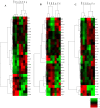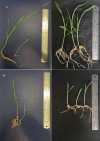Characterization of bacterial diversity between two coastal regions with heterogeneous soil texture
- PMID: 36344551
- PMCID: PMC9640712
- DOI: 10.1038/s41598-022-23487-0
Characterization of bacterial diversity between two coastal regions with heterogeneous soil texture
Abstract
Studying microbial diversity and the effects of external factors on the microbiome could expand our understanding of environmental alterations. Silt and sand are mineral particles that form soil texture and even though most of the soils on earth contain a fraction of them and some other soils form almost by them, their effects on the microbiome remained to elucidate. In this study, the bacterial biodiversity of sand and silt clay soils was investigated. Furthermore, their effects on plant growth have been determined. Our data showed that biodiversity and biomass of microbiome are higher in silt-based soil. It is interesting that the pseudomonas genera only exist in silt-based soil while it is in the absence of sand-based soil. In contrast, B. thuringiensis could be found in sand-based soil while it is not found in silt texture. Our data also demonstrated that there are no significant changes in stress response between the two groups however, differential physiological changes in plants inoculated with silt and sand based bacterial isolates have been observed. This data could indicate that smaller size particles could contain more bacteria with higher biodiversity due to providing more surfaces for bacteria to grow.
© 2022. The Author(s).
Conflict of interest statement
The authors declare no competing interests.
Figures




Similar articles
-
[Effects of Soil Texture on Autotrophic CO2 Fixation Bacterial Communities and Their CO2 Assimilation Contents].Huan Jing Ke Xue. 2016 Oct 8;37(10):3987-3995. doi: 10.13227/j.hjkx.2016.10.042. Huan Jing Ke Xue. 2016. PMID: 29964436 Chinese.
-
Low pore connectivity increases bacterial diversity in soil.Appl Environ Microbiol. 2010 Jun;76(12):3936-42. doi: 10.1128/AEM.03085-09. Epub 2010 Apr 23. Appl Environ Microbiol. 2010. PMID: 20418420 Free PMC article.
-
Effect of bovine manure on fecal coliform attachment to soil and soil particles of different sizes.Appl Environ Microbiol. 2007 May;73(10):3363-70. doi: 10.1128/AEM.02434-06. Epub 2007 Mar 16. Appl Environ Microbiol. 2007. PMID: 17369341 Free PMC article.
-
Potential of Microbial Diversity of Coastal Sand Dunes: Need for Exploration in Odisha Coast of India.ScientificWorldJournal. 2019 Jul 14;2019:2758501. doi: 10.1155/2019/2758501. eCollection 2019. ScientificWorldJournal. 2019. PMID: 31391794 Free PMC article. Review.
-
Micro-scale determinants of bacterial diversity in soil.FEMS Microbiol Rev. 2013 Nov;37(6):936-54. doi: 10.1111/1574-6976.12023. Epub 2013 May 9. FEMS Microbiol Rev. 2013. PMID: 23550883 Review.
Cited by
-
A culture-independent approach, supervised machine learning, and the characterization of the microbial community composition of coastal areas across the Bay of Bengal and the Arabian Sea.BMC Microbiol. 2024 May 10;24(1):162. doi: 10.1186/s12866-024-03295-4. BMC Microbiol. 2024. PMID: 38730339 Free PMC article.
-
Analysis of soil microbial community structure changes in the drainage field of the Shengli coalfield based on high-throughput sequencing.BMC Microbiol. 2025 Mar 12;25(1):132. doi: 10.1186/s12866-025-03761-7. BMC Microbiol. 2025. PMID: 40069602 Free PMC article.
References
-
- Amundson R. Factors of soil formation in the 21st century. Geoderma. 2021;391:114960. doi: 10.1016/j.geoderma.2021.114960. - DOI
-
- Nannipieri P, Ascher J, Ceccherini M, Landi L, Pietramellara G, Renella G. Microbial diversity and soil functions. Eur. J. Soil Sci. 2003;54(4):655–670. doi: 10.1046/j.1351-0754.2003.0556.x. - DOI
MeSH terms
Substances
LinkOut - more resources
Full Text Sources

